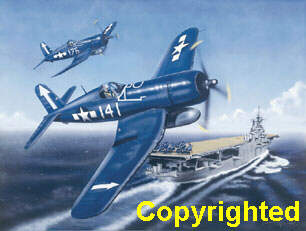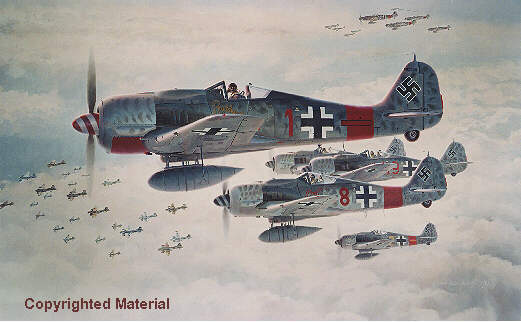 This
is a class to familiarize you with flying or "winging" with a partner.
When flying with a wingmate, you are a deadly combo that can take out a
lot of enemy. While flying solo is ok and fun to do, winging with someone
can add a whole new perspective to the game.
This
is a class to familiarize you with flying or "winging" with a partner.
When flying with a wingmate, you are a deadly combo that can take out a
lot of enemy. While flying solo is ok and fun to do, winging with someone
can add a whole new perspective to the game.
First you have to get a partner. I recommend someone you have flown with before. If you are in a squad, you will most likely be assigned a winging partner. You and your partner should fly together as much as possible. You both need to be familair with the other's flying style. It is important. You want to be able to, eventually, get into an engagement and be comfortable about your partner's ability. This will come with a lot of practice and flight time together. It's all about knowing what your partner is doing in a fight, and knowing the abilities of the person you are flying with.
I have been told by some excellent wingmates that a good thing to do is to fly against your partner (in a training setting, not in actual combat), and film the fights. It's a excellent idea! Exchange the films and take a look. See if you can see where your partner might have made a mistake. Try to see if they have any weaknesses. Look at what he is doing right. Talk with your wingmate about the films. You will both learn a lot from doing this. And it will benefit your winging . You will become more familar with your wingmate and it will help you figure wich strategies would work best for you. You can also "plan" around each others "weaknesses".
 Whoever
leads the flight, determines where you will go, if you will engage or not,
what strategies will be used He/she will decide what plane poses the most
threat, when to rtb, ect... The wingmates job is to stay with the leader,
watch the dar for other incoming traffic during an engagement (when feasable),
to be ready when the leader is in trouble (again depending on what tactic
you use). Take turns "leading" a flight. In some tactics, the "leader"
role happens in the air.
Whoever
leads the flight, determines where you will go, if you will engage or not,
what strategies will be used He/she will decide what plane poses the most
threat, when to rtb, ect... The wingmates job is to stay with the leader,
watch the dar for other incoming traffic during an engagement (when feasable),
to be ready when the leader is in trouble (again depending on what tactic
you use). Take turns "leading" a flight. In some tactics, the "leader"
role happens in the air.
One of the problems that most occurs is the deciding of the leader. It may seem like a small matter, but when you are in the arena, things can , and always do, happen very fast. If you don't finalize the small decisions before you go up, things aen't going to go as well as they should.
When going to a target, the leader has to be aware
of formation flying. Leader, keep calling the headings, IAS, CR. Partner,
make sure you acknowledge these. If there is no acknowledgement, the leader
could be left hangingo n what to do, and that could be the difference of
life and death.
If there is a lone enemy, one wingmate can engage while the other stays high. Fly over the fight. This will allow the non-engaged partner to watch and see if the engaged wingie gets into trouble, and you can scan the sky & dar for incoming traffic. You can keep the engaged wingie informed of whats going on. PLUS, it makes the enema nervous as Hell! :) If a enemy does come your way, and you think your partner is doing ok, radio your intentions, and get an acknowledgement from him.
Another variation you could use would be to seperate about 1500-2000 yds and go in parallel. Look to see what the enemy does. Assuming its a pair you're fighting, you could blow through them and try to get them to do a hard reversal. Or if they both turn towards one of you, the one being persued can begin a low G zoom and the free person will turn onto the two enemies tails and try to get one fast easy kill. And when the other guy realizes his mistake, the chasee becomes the chaser. You can trade places and try to "bait" the other guy into leveling out so you can kill him.
If they enemy also seperates and attacks you both 1 vs 1, try to keep the 1 vs 1 going till one of the enemy is dead. After a quick check on dar for incoming, kill the other guy quickly.
Keep in mind, these are not set in stone. You will, more times than not, have to modify your strategy to how the enemy reacts. This is where your communication will be most important. Making quick decisions.
If you are going up against 2 vs 2, let your partner know which plane you are going to engage, or let the leader call it. Still keep an eye on your wingmate in case he gets into trouble. You can unsaddle from the plane you are engaged with to give a hand, or to even just distract the enemy. This takes practice, so have patience.
Covering your wingie is as or more important than getting the kill. If he (or you) dies, chances are real good, so will the other...sooner than if you both were around.
There are no real "rules" in winging with your partner.....ok maybe one...don't leave your wingie with his "pants down" or flying alone.
The opening move in Wing tactics is crucial. The first shot often dictates who will win. Practice with your partner lead turns. Have him fly straight at you level, high speed. Try the lead turn at the same alt at first. Repeat it until you are able to judge the right distance to get on him. Then try vertical lead turns. Same set up. He fly's towards you, but you are below him.
Have fun with this! Winging is an incrediable experience. It takes time and practice, but after that first successful strategy that got you some kills, and a change to return home, you will know that it was well worth the effort.